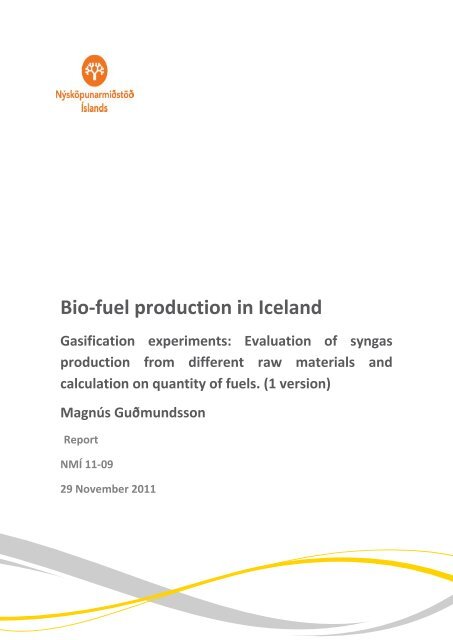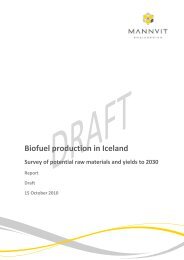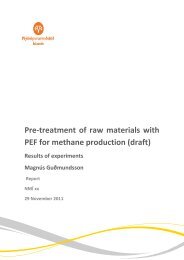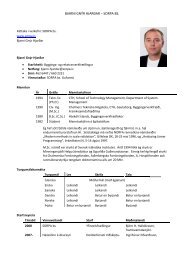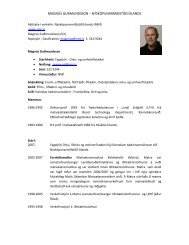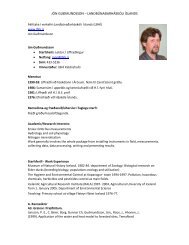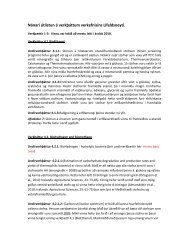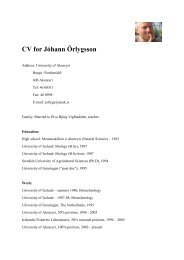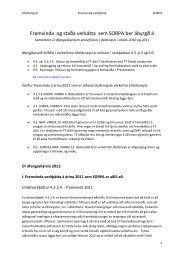Bio-fuel production in Iceland
Gasification
Gasification
- No tags were found...
You also want an ePaper? Increase the reach of your titles
YUMPU automatically turns print PDFs into web optimized ePapers that Google loves.
<strong>Bio</strong>-<strong>fuel</strong> <strong>production</strong> <strong>in</strong> <strong>Iceland</strong>Gasification experiments: Evaluation of syngas<strong>production</strong> from different raw materials andcalculation on quantity of <strong>fuel</strong>s. (1 version)Magnús GuðmundssonReportNMÍ 11-0929 November 2011
Keldnaholt112 Reykjavík<strong>Iceland</strong>Tel: +354 522 9000Fax: +354 522 9001Mail: magnusg@nmi.isInnovation Center of <strong>Iceland</strong>Web: www.nmi.com1
Table of contentsList of Figures and Tables ............................................................................................................. 31 Introduction .............................................................................................................................. 42 Raw materials for gasification and experiments ......................................................................... 52.1 Waste categories chosen for gasification ................................................................................ 53 Gasification method .................................................................................................................. 64 Syngas ...................................................................................................................................... 74.1 Composition from experiments ............................................................................................... 75 Fuels from syngas .................................................................................................................... 105.1 Production of FT-<strong>fuel</strong>s ........................................................................................................... 105.2 <strong>Bio</strong>-ethanol .......................................................................................................................... 145.3 <strong>Bio</strong>hydrogen ......................................................................................................................... 165.4 <strong>Bio</strong>-methanol ....................................................................................................................... 185.5 <strong>Bio</strong>DME ................................................................................................................................ 206 Conclusions ............................................................................................................................. 21References ................................................................................................................................. 242
List of Figures and TablesTablesTable 1. Waste categories , their carbon content and energy value * ................................................... 5Table 2. Syngas composition and amount for each category ................................................................ 7Table 3. Literature values of syngas produced from biomass ,MSW and other wastes ........................ 8Table 4. Syngas <strong>production</strong> from MSW and biomass with 50% carbon content. Production from 1ton of dry raw material. .......................................................................................................................... 9Table 5. FT-products from 200.000 tons of dry biomass or MSW with 50% carbon content ............. 11Table 6. Calculation of FT-products based on syngas composition and energy values for each ton ofdry raw material .................................................................................................................................... 12Table 7. Calculation of Ethanol-products based on syngas composition and energy values for eachton of raw material ............................................................................................................................... 15Table 8. Calculation of hydrogen based on syngas composition and energy values for each ton of rawmaterial ................................................................................................................................................. 17Table 9. Production of methanol from 200 thousand tons of available MSW and organic waste. 75%efficiency assumed ................................................................................................................................ 18Table 10 . Calculation of methanol based on syngas composition and energy values for each ton ofraw material .......................................................................................................................................... 19Table 11. Production of DME from 200 thousand tons of raw material (MSW and organic waste)assum<strong>in</strong>g 75% efficiency <strong>in</strong> <strong>production</strong> from the syngas...................................................................... 20Table 12. Calculation of DME based on syngas composition and energy values for each ton of rawmaterial ................................................................................................................................................. 21Table 13. The total <strong>production</strong> of <strong>fuel</strong>s possible from available raw material 250 thousand (dryweight 200 thousand). 75% efficiency is assumed for syngas conversion to <strong>fuel</strong>. ............................... 22Figuresfigure 1. PID gasifier <strong>in</strong>clud<strong>in</strong>g sample tank, reactor, cyclones for solids, scrubber and gas collector . 63
1 IntroductionThis report deals with <strong>production</strong> of syngas with gasification from potential raw materialsand <strong>production</strong> of <strong>fuel</strong>s from the syngas. The <strong>production</strong> of syngas and syngas based <strong>fuel</strong>sare evaluated based on results from on high temperature and plasma gasification.Calculations are also based on experiments on selected raw materials from SORPA that aregasified with an experimental small scale gasifier. As the experimental gasifier is not a hightemperature gasifier the syngas <strong>production</strong> is somewhat different compared to largecommercial high temperature gasifiers, but it still gives an idea how the raw material reactsto gasification. The categories of raw material tested with the experimental gasifier arehomogeneous materials and are dealt with as special cases for syngas <strong>production</strong>. Thesyngas produced with the experimental gasifier is evaluated accord<strong>in</strong>g to composition andcompared to literature f<strong>in</strong>d<strong>in</strong>gs. Possible <strong>fuel</strong> <strong>production</strong> from the syngas based on theexperimental gasifier is calculated and compared to other f<strong>in</strong>d<strong>in</strong>gs.Syngas composition and total amount of carbon monoxide and hydrogen determ<strong>in</strong>es theamount of <strong>fuel</strong> that can be produced from it. It is therefore essential to have a goodestimate on what k<strong>in</strong>d of syngas each waste material category produces <strong>in</strong> order to makeany sensible <strong>production</strong> plans.The calculation of the different <strong>fuel</strong> types are made from syngas composition and totalsyngas <strong>production</strong> as well as the energy content of the syngas. The calculations based onliterature values from high temperature and plasma gasification are compared tocalculations based on experimental values of syngas. The calculations of total <strong>fuel</strong><strong>production</strong> is based on the amount of raw material available that has been estimated <strong>in</strong>previous report on gasification where possible raw material for gasification was estimated.The calculations of <strong>fuel</strong> <strong>production</strong> based on the special categories tested rely on<strong>in</strong>formation of what is known about each category as well as the experimental results of thepilot gasifier.4
2. Raw materials for gasification and experimentsThe raw materials chosen for gasification experiments were made by SORPA. There were tobeg<strong>in</strong> with four categories chosen for treatment. The calculations of <strong>fuel</strong> <strong>production</strong> arebased on literature values and experimental values of composition and energy content aswell as the estimate for potential raw material found <strong>in</strong> previous report.2.1 Waste categories chosen for gasificationThe waste categories chosen for gasification are ma<strong>in</strong>ly plastics, saw dust, wood chips,glycerol and mixed paper which is shown with other categories <strong>in</strong> table 1.Table 1. Waste categories , their carbon content and energy value *Category Carbon content (%) Energy content (MJ/kg)Mixed plastics 50-55 20-40Saw dust 48.8 10-15Dry hay 49-50 7-10Paper 50-55 10-15Cardboard 50 16Dried organic waste 45-50 10-12Glycerol 36 19Waste oils 35-40 25-35Carton 50-55 10-15Polyethylene 85.8 38Polypropylene 86.3 44*Based on (Mayers 2007, EIA 2005, Xiao etal 2006, Noosai 2006, Tsuji 2009)The above mentioned categories were specifically chosen for the experimental gasifier fortest<strong>in</strong>g and are very homogenous compared to raw material chosen for large scale hightemperature or plasma gasification which usually takes <strong>in</strong> heterogeneous materials. Alsothe raw material for experimental gasifier must be dry and reduced <strong>in</strong> particle size down to5
less than 2 mm which is usually not necessary for most commercial gasifiers. The carboncontent of the categories was evaluated <strong>in</strong> previous report except for the polyethylene andpolypropylene taken from literature and glycerol which is calculated from its molecularformula.3. Gasification methodThe gasification have been done by a experimental gasifier from PID (PID Eng &Tech 2010),and one such is located at the CRI laboratory located at Höfðabakki. Material from SORPAhas been used for gasification experiments and some were done <strong>in</strong> Spa<strong>in</strong> at the PIDheadquarter location. The equipment can handle one kilo of raw material for eachexperiment. The maximum temperature <strong>in</strong> the reactor is 850°C. The gasification of eachsample takes one hour and the syngas produced is measured as well as its composition. Thiscan be done with gas flow meter and gas chromatograph. A schematic picture is seen <strong>in</strong>figure 1 which <strong>in</strong>cludes a collection tank where the raw material is fed <strong>in</strong>to the reactor, areactor where the gasification takes place, two cyclones for tak<strong>in</strong>g the solid particles out ofthe gas, water scrubber for clean<strong>in</strong>g the gas and f<strong>in</strong>ally a gas collector for the syngas.Figure 1. PID gasifier <strong>in</strong>clud<strong>in</strong>g sample tank, reactor, cyclones for solids, scrubber and gas collector6
Commercial gasifiers are of several types where down draft, updraft and entra<strong>in</strong>ed flowgasifiers are the most usual ones, but also fluid bed gasifiers. Plasma gasifiers are lessdeveloped but they are at the moment extensively tested. These gasifiers operate at highertemperatures than the PID gasifier or from 1200 to 2000°C <strong>in</strong> the reactor that result <strong>in</strong>somewhat different yield of syngas. The gasifiers are air, oxygen or steam driven and thataffects the composition of the syngas as well as its energy value so the same raw materialcan give different results depend<strong>in</strong>g on gasification process used.4. SyngasThe syngas can have very different composition depend<strong>in</strong>g on the raw material and the totalamount of syngas produced is very much depended on total amount of carbon <strong>in</strong> the rawmaterial. The gasification methods are also important as high temperature and plasmagasification usually have higher yield of produced syngas because of better reactions <strong>in</strong> thereactor.4.1 Composition from experimentsIn syngas <strong>production</strong> it is most important to produce as much hydrogen and CO and as lowamount of other gases as possible.The syngas produced with PID gasifier is not expected to be different from syngas withcommercial gasifiers except the yield can be lower. The results are shown <strong>in</strong> table 2 i.e. theamount of gas and composition based on cleaned gas and N 2 free.Table 2.Syngas composition and amount for each categoryCategory H 2 CO H 2 /CO ratio M 3 /kgPaper 25-35 30-33 0.8-1 0.8-1Wood dust 30-36 26-32 0.9-1.1 0.9-1Plastics 25-27 32-35 0.8-0.9 1-1.1Glycerol 30 32 0.9 1The syngas composition and total amount compares relatively well to other literature valuesas can be seen <strong>in</strong> table 3 for other f<strong>in</strong>d<strong>in</strong>gs.7
Table 3. Literature values of syngas produced from biomass , MSW and other wastesType of H 2 /CO % H 2 %CO M 3 /kg MJ/Nm 3 Referencesmaterial ratiowaste syngas<strong>Bio</strong>mass 1.0 42.2 38.7 1 14 ChorenRDF 0.75 37.8 46.6 0.8-1 10-15 ScanarcRDF 0.7 37 51 2.35 6 Rao etalHigh <strong>in</strong>comecountry MSWCardboard/paper0.7 32.2 43.8 1.56 Filippis etal1-1.5 45 25 1 11 Noosai etalPolyethylene 0.8-1.3 25-37 27.4-33 1.2 14 He etalPolypropylene 0.23 16 55 3.8 5.2 Xiao etalWood 0.9-1.0 24-40 37-44 11 KnoefWood 0.9 32 37 GautamWood chips 0.9 35 40 2.66 5 Rao etalP<strong>in</strong>e sawdust 1.8-4 33-52 14-29 1.8-2.2 Lv etalGlycerol 1 47 45 1 13.5 VallyappanAs the values <strong>in</strong> table 3 are from different gasification techniques where some are us<strong>in</strong>g airand other are us<strong>in</strong>g oxygen or steam, then the values for amount of gas produced and itscalorific value differ widely as air driven gasifiers will produce crude syngas which conta<strong>in</strong>snitrogen with greater volume but are lower <strong>in</strong> calorific value compared to syngas whicheither has been purified or is us<strong>in</strong>g oxygen <strong>in</strong> the gasification process.The amount and ratio of H 2 and CO can be very diverse as seen <strong>in</strong> table 3. The type of rawmaterial and gasification method control the outcome especially the ratio of the two gases.High amount of hydrogen depends on comb<strong>in</strong>ation of raw material and us<strong>in</strong>g steam <strong>in</strong>gasification process (Lv et.al. 2007). Also greater energy content of the raw material results<strong>in</strong> syngas with greater energy value. The amount of moisture <strong>in</strong> the raw material andgasification method (us<strong>in</strong>g air, oxygen or steam) affects therefore the energy value of thesyngas.For comparison with experiments and to estimate <strong>production</strong> based on available rawmaterial it is necessary to use results from already established <strong>production</strong>. To calculate8
syngas <strong>production</strong> from the potential available raw material, it was estimated <strong>in</strong> previousreport that biomass and MSW <strong>in</strong> <strong>Iceland</strong> conta<strong>in</strong> at least 50% carbon <strong>in</strong> the ash andmoisture free raw material. The ratio of H 2 and CO was estimated to be close to one basedon chemical composition of organic matter and that no other chemicals are formed exceptcarbon dioxide. The calculations for syngas <strong>production</strong> <strong>in</strong> large scale are based on theprocesses of Scanarc and Choren as shown <strong>in</strong> table 4. The amount of CO 2 is 14% for Scanarcand 19% for Choren.Table 4. Syngas <strong>production</strong> from MSW and biomass with 50% carbon content.Production from 1 ton of dry raw material.Syngas with H 2 /CO ratio 0.75Pyroarc process from ScanarcSyngas with H 2 /CO ratio 1Process of ChorenCO H 2 CO H 2905 kg 49 kg 770 kg 56 kgThe <strong>production</strong> of syngas <strong>in</strong> cubic meters from biomass or MSW is 0.8-1 Nm 3 for every kiloof raw material (Circeo 2007 and Scanarc 2005). Energy value (LHV=low heat<strong>in</strong>g value) of COis 284 kJ/mol and hydrogen is 286 kJ/mol or 120.1 MJ/kg (Handbook of biomass gasification2005). This gives roughly 15-16 MJ/kg for syngas as there is approximately 1kg/Nm 3 . Asshown <strong>in</strong> table 3 for different literature values this is correct. Some have wider range of theenergy content or 15 to 20 MJ/Nm 3 that depends of us<strong>in</strong>g oxygen or steam (Geurds, 2006).It is estimated that 75-80% of the energy content of the raw material will be conta<strong>in</strong>edwith<strong>in</strong> the syngas but 20 to 25% will be released <strong>in</strong> form of thermal energy (Handbook ofbiomass gasification).The syngas that is produced conta<strong>in</strong>s mostly H 2 , CO, CO 2 and CH 4 . For most <strong>fuel</strong>s it ispreferable that mole ratio of CO and H 2 is 1:2. However, the ratio of H 2 /CO <strong>in</strong> the syngas isusually <strong>in</strong> the range 0.7 to 1.4 and biomass has the ratio close to one.The reason why the ratio is close to 1:1 is because of the similar ratio of carbon andhydrogen <strong>in</strong> organic waste and biomass:C 6 H 12 O 6 = 6 CO + 6 H 29
This leads to formation of CO and H 2 <strong>in</strong> roughly equal ratios <strong>in</strong> the syngas (Petrus andNoordermeer 2006). That is why it is often necessary to use water gas shift reaction toproduce <strong>fuel</strong>s from the syngas to adjust the ratio between CO and H 2 . This is done byreact<strong>in</strong>g CO with steam. Usually before syngas is used the CO 2 is separated from the syngaswith chemical adsorption, liquid clean<strong>in</strong>g or with physical adsorption. It is possible todecrease the concentration of CO 2 to 0.1%. The use of the concept syngas <strong>in</strong> this reportrefers to cleaned syngas which conta<strong>in</strong>s only hydrogen and carbon monoxide and onlytraces of other gases.5. Fuels from syngasIt is possible to produce many <strong>fuel</strong> types from the syngas but the most important are; FTdiesel,ethanol, hydrogen, methanol and DME. The follow<strong>in</strong>g calculations are based on thegasification experiments and amount of available raw material <strong>in</strong> <strong>Iceland</strong> especially <strong>in</strong>Reykjavik and surround<strong>in</strong>gs. As there are variations <strong>in</strong> syngas composition and amount ofsyngas from each kilo and also the yield can also vary it should be evident that there are alsosome variations <strong>in</strong> <strong>fuel</strong> <strong>production</strong> (upper and lower limit). Calculations are done for eachtype of <strong>fuel</strong> separately.5.1 Production of FT-<strong>fuel</strong>sI. Results based on literature <strong>in</strong>formationFT-diesel and FT-products can be produced from purified syngas. As po<strong>in</strong>ted out <strong>in</strong> aprevious report, the yield of purified syngas to FT-<strong>fuel</strong>s is from 60% to 75% based on energycontent of the syngas (Optal 2007, Fürns<strong>in</strong>n 2006 and Kavlov 2005). Also mentioned <strong>in</strong>previous report the ratio of H 2 /CO is very important and needs to be 1.7 to 2.15 for optimaluse of the syngas for FT <strong>production</strong>.If the ratio is lower, the CO can only be used partially. To improve the <strong>production</strong> hydrogenfrom electrolysis can be used or hydrogen produced by water gas shift reaction from CO andsteam. The use of water gas shift reaction can <strong>in</strong>crease the <strong>production</strong> by 50% if the start<strong>in</strong>g10
atio is one for the ratio H 2 /CO and the use of hydrogen from electrolysis could double the<strong>production</strong>. In most cases the ratio of CO and H 2 with<strong>in</strong> the syngas is outside the preferredlimit so usually the shift reaction is used for compensation. Both methods are used forcalculations of FT-<strong>fuel</strong>.About 60% of the FT-products are diesel, 15% is naphtha and 25% is kerosene.As shown <strong>in</strong> the previous report it is considered possible to obta<strong>in</strong> about 225 thousand tonsof organic waste if it were collected from the capital area, the west and south of the countryas well as the Reykjanes pen<strong>in</strong>sula. It was also considered possible to collect about 44thousand tons of organic waste from agriculture <strong>in</strong> the country that is not used for otherpurposes. Accord<strong>in</strong>g to these figures it should be possible to obta<strong>in</strong> 200 thousand tons ofraw materials by dry content for gasification to produce <strong>fuel</strong> as the water content is usuallybetween 15 to 20% <strong>in</strong> the orig<strong>in</strong>al raw material. This could be considered upper limit forpossible raw material collection <strong>in</strong> the above mentioned areas.The amount of products that can be produced from 200 thousand tons of raw material with50% carbon content on dry matter basis are shown <strong>in</strong> Table 5 based on Choren and Scanarcprocesses.The amount of compounds <strong>in</strong> the table assumes that water gas shift reaction is used asneeded but when added hydrogen from electrolysis is used the carbon monoxide is not used<strong>in</strong> water gas shift reaction.Table 5. FT-products from 200.000 tons of dry biomass or MSW with 50% carboncontentProductsWithout added hydrogen(ton)11With added hydrogen(ton)diesel* 24400 - 27720 36060-41520Naphtha* 5800 - 6380 9015-10380kerosene* 9450 - 10620 15025-17300Total 39650 - 44720 60100-69200*FT-diesel has density of 0.85 kg/L, but naphtha and gasol<strong>in</strong>e are 0.72 kg/LIf the water gas shift reaction is not used to balance the ratio between hydrogen and COthen additional hydrogen is needed. The extra hydrogen can be obta<strong>in</strong>ed by electrolysis,
which will also provide more oxygen than is needed for the <strong>production</strong>. If additionalhydrogen is used from electrolysis then the <strong>production</strong> could be <strong>in</strong>creased from 55 to 75%compared to when water gas shift reaction is used mak<strong>in</strong>g the total <strong>production</strong> to bebetween 60 to 69 thousand tons of FT-products as seen <strong>in</strong> table 5. This <strong>production</strong> is equalto 1/3 of the <strong>fuel</strong> consumption of all cars <strong>in</strong> <strong>Iceland</strong>.II. FT-<strong>fuel</strong> <strong>production</strong> based on different categoriesTable 6 shows possible <strong>production</strong> of FT-<strong>fuel</strong> products based on literature values as shown<strong>in</strong> table 3 for some categories other than biomass.Table 6. Calculation of FT-products based on syngas composition and energy values foreach ton of dry raw materialCategoryBased on syngas calorific valueand syngas m 3KgBased on syngas composition andsyngas m 3MSW 185 163RDF 194 200Wood 195 200Glycerol 200 184Polyethylene 248 251Sawdust 162 166Polypropylene 269 197Cardboard/paper 162 182KgThere is a relatively good fit between the two calculation methods except for polypropylene.The method used for syngas <strong>production</strong> from polypropylene was based on low steamgasification (Xiao etal. 2006) that results <strong>in</strong> very low hydrogen amount <strong>in</strong> the syngas whichresults <strong>in</strong> rather low <strong>production</strong> when based on syngas composition.12
If these figures were used as basis for calculation for <strong>production</strong> of FT-<strong>fuel</strong>s from MSW theywould result <strong>in</strong> 32 to 38 thousand tons of <strong>fuel</strong> from 200 thousand tons of MSW raw materialwithout added hydrogen from electrolysis. This is somewhat a lower range than found forChoren and Scanarc processes for biomass and MSW.It is possible to produce RDF (refuse derived <strong>fuel</strong>) from selective part of MSW and its energycontent is slightly higher than for MSW <strong>in</strong> general. As there is no <strong>production</strong> of RDF <strong>in</strong><strong>Iceland</strong> it is not possible to estimate <strong>fuel</strong> <strong>production</strong>.It has been estimated that wood chips from forestry <strong>in</strong> <strong>Iceland</strong> is around 7-8 thousand tonsand wood and timber <strong>in</strong> MSW from area with<strong>in</strong> 80 km from Reykjavik is about 30 thousandtons (previous report, Sorpa 2006 and Sorpa 2010). If this raw material were gasified andmade <strong>in</strong>to FT-<strong>fuel</strong>s the total amount would be 7400 to 8170 tons on annual basis. Based onthe pilot scale gasifier the <strong>production</strong> would be lower or 5700 tons.It has been estimated that total waste packag<strong>in</strong>g plastics that are collected is around 20thousand tons (Umbúðarskýrsla 2005) for the country and Sorpa is collect<strong>in</strong>g some fewthousand tons per year (Ársskýrslur 2006, 2007 and 2010). If it were mostly polyethyleneand polypropylene it would be possible to produce 5020 to 6100 tons of FT-<strong>fuel</strong>s. All plasticscan be used for gasification without much clean<strong>in</strong>g of the syngas except PVC and PET asthese two categories conta<strong>in</strong> chloride or other detrimental chemicals which need gasclean<strong>in</strong>g. PVC and PET are about 13% of all waste plastics (Umbúðarskýrsla 2005). Resultsfrom the pilot scale gasifier <strong>in</strong>dicate that it would be possible to produce about 4700 tons.Glycerol is only produced <strong>in</strong> small amount <strong>in</strong> <strong>Iceland</strong> as a by-product from biodiesel<strong>production</strong>. It has been estimated that there is at least 3-4 thousand tons of waste oil <strong>in</strong> thecountry and if it were used for biodiesel <strong>production</strong> about 300-400 tons of glycerol could beproduced. Also if plans for rapeseed cultivation and biodiesel <strong>production</strong> from the oil aresuccessful and about 10 thousand tons of oil where produced about one thousand ton ofglycerol would be produced as by-product <strong>in</strong> bio-diesel <strong>production</strong>. In the near future about1400 to 1500 tons of crude glycerol could be produced which if gasified and made <strong>in</strong>to FTproductswould make 275 to 340 tons of FT-<strong>fuel</strong>s. The results from the pilot scale gasifier<strong>in</strong>dicate that it would be possible to produce 200-250 tons. These are very small amountsand would not be a primary raw material for gasification.13
The paper and card board material that was recycled is about 17000 tons (Sorpa 2006) andit is estimated that about 20.000 tons of packag<strong>in</strong>g material from paper /cardboard is <strong>in</strong> thecountry (Umbúðarskýrsla 2005). As these figures could overlap it is estimated that thequantity is at the lower level of 17 thousand tons. This could produce 2700 to 3100 tons ofFT-<strong>fuel</strong>s. The results from pilot gasifier <strong>in</strong>dicate that the <strong>production</strong> could be 2500 ton.5.2 <strong>Bio</strong>-ethanolI. Ethanol <strong>production</strong> based on literatureAs has been described <strong>in</strong> the earlier report it is possible to produce ethanol withfermentation of syngas. This is done with anaerobic bacteria e.g. Clostridium ljungdahlii thatproduces ethanol and acetate. The ma<strong>in</strong> advantage of us<strong>in</strong>g syngas fermentation is that it isnot dependent on special ratio between H 2 , CO and CO 2 as is necessary <strong>in</strong> the FT-process.High CO content keeps methanogenic bacteria at m<strong>in</strong>imum. The process is:6CO+3H 2 O=C 2 H 5 OH+4CO 26H 2 + 2CO 2 = C 2 H 5 OH + 3H 2 OThe only chemicals formed besides the ethanol are carbon dioxide and water.The company BRI (<strong>Bio</strong>eng<strong>in</strong>eer<strong>in</strong>g Resources Inc.; www.Brienergy.com) now owned byIneos <strong>Bio</strong> (www.<strong>in</strong>eosbio.com) has developed a method to produce ethanol from syngasbased on C. ljungdahlii. Coskata (coskata.com) is now runn<strong>in</strong>g a pilot plant to produceethanol from syngas made available from plasma gasification.Accord<strong>in</strong>g to Ineos <strong>Bio</strong> the efficiency is between 322 to 400 liters from every ton of biomass(Ineosbio.com). The energy efficiency <strong>in</strong> ethanol <strong>production</strong> from biomass has beenestimated to be 35-45% (Vessia 2005) based on the total calorific value of the biomass. Theefficiency from syngas to ethanol is estimated to be similar as for FT-<strong>fuel</strong>s or 65 to 75%.TheIneos <strong>Bio</strong> process has better energy efficiency accord<strong>in</strong>g to their <strong>in</strong>formation.The estimate of total <strong>production</strong> of ethanol from gasification and syngas <strong>production</strong> fromavailable raw material from MSW and agricultural waste can be estimated directly from14
tonnage of raw material accord<strong>in</strong>g to figures from Ineos <strong>Bio</strong>. The total amount of dry rawmaterial was estimated to be 200 thousand tons and that amount of raw material couldproduce 64 to 80 thousand m 3 or about 50.5 to 63.2 thousand tons of ethanol.If the calculations are based on the same syngas composition and the same conversionefficiency as for FT-<strong>fuel</strong> <strong>production</strong> then the <strong>production</strong> would be 70 thousand tons. The<strong>production</strong> could therefore be between 50 and 70 thousand tons.II. Ethanol <strong>production</strong> based on different categoriesIn table 7 are shown the <strong>production</strong> of ethanol for several categories of raw material as forFT-<strong>fuel</strong>s based on results from references <strong>in</strong> table 3.Table 7. Calculation of Ethanol-products based on syngas composition and energy values foreach ton of raw materialCategoryBased on syngas calorific valueand syngas m 3 KgBased on syngas compositionand syngas m 3MSW 307 264RDF 323 334Wood 325 335Glycerol 332 307Polyethylene 414 418Sawdust 271 240Polypropylene 448 348Cardboard/paper 271 304KgIt is relatively good fit between calculations based on calorific value and syngas amount andcalculations based on syngas composition and syngas amount except for polypropylene. Theprocess for polypropylene was based on low steam addition so hydrogen was produced <strong>in</strong>low amount, which could expla<strong>in</strong> partially the different calculations. Based on these figuresthe annual <strong>production</strong> of ethanol could be <strong>in</strong> the range from 53 to 80 thousand tons of15
ethanol, which is similar as the estimation based on data from Ineos <strong>Bio</strong> and Scanarc andChoren processes.In a similar way as for FT-<strong>fuel</strong>s it is possible to calculate <strong>production</strong> of each category fromavailable raw material <strong>in</strong> <strong>Iceland</strong>.From wood and wood chips it is possible to produce 12 to 13 thousand tons of ethanol.From 20 thousand tons of plastics it would be possible to produce 7 to 9 thousand tons ofethanol. From glycerol 400 to 500 tons could be produced.From 17.000 tons of paper/cardboard it is possible to produce about 4600 to 5200 tons ofethanol.If the figures from the pilot gasifier are used then it would be possible to produce 9.4thousand tons from the wood and timber, 4.1 thousand tons from paper, about 7.9thousand tons from the plastics and roughly 330 tons from glycerol.5.3 <strong>Bio</strong>-hydrogenI. Hydrogen generalGasification of biomass and MSW can produce between 6 and 6.5% of the weight of thebiomass as hydrogen (Bridgwater 2003) and up to 37-42% of the syngas volume is hydrogen(Scanarc 2007, Choren 2010). Other categories of waste can even produce higher amount ofhydrogen as glycerol (Vallyappan 2008) or cardboard (Noosai etal 2006). The hydrogencontent depends also on whether air, oxygen or steam is used <strong>in</strong> the gasification process.When steam is used <strong>in</strong> the gasification then the amount of hydrogen will <strong>in</strong>crease but moreenergy is used <strong>in</strong> the <strong>production</strong> of the syngas. It is also possible to use the water gas shiftreaction to react CO with steam to produce more hydrogen accord<strong>in</strong>g to the equation:CO + H 2 O = CO 2 + H 2From 200.000 tons of dry MSW it is possible to produce between 18.000-20.000 tons byus<strong>in</strong>g water gas shift reaction. These figures are based on Choren and Scanarc processes onbiomass and MSW. This amount of hydrogen could also be produced by electrolysis with120-140 MW of electric hydropower.16
II. Hydrogen <strong>production</strong> based on different categoriesIt is also possible to estimate <strong>production</strong> from <strong>in</strong>dividual categories from table 3 as shown <strong>in</strong>table 8.Table 8. Calculation of hydrogen based on syngas composition and energy values for eachton of raw materialCategoryBased on syngas calorific valueand syngas m 3KgBased on syngas compositionand syngas m 3MSW 78 69RDF 82 87Wood 83 88Glycerol 84 80Polyethylene 105 109Sawdust 69 62Polypropylene 113 91Cardboard/paper 69 73KgThere is a relatively good fit between the calculations that are based on calorific value andamount of syngas and on composition of syngas and amount of syngas except forpolypropylene and the explanation could be the same as before.Based on these figures the total <strong>production</strong> from 200 thousand tons of dry MSW andorganic waste should be between 16 to 18 thousand tons, which is somewhat lower thanthe former estimate based on Choren and Scanarc processes.If hydrogen were produced from available wood material it would be possible to producebetween 3100 and 3250 tons of hydrogen. Based on the pilot gasifier the amount would be2500 ton.17
If all the waste plastics were used for <strong>production</strong> about 2100 to 2200 of hydrogen could beproduced and based on pilot gasifier it would be 2000 tons.From glycerol it would be possible to produce about 125-130 tons of hydrogen but frompilot gasifier it would be 90 tons.From paper/cardboard waste it would be possible to produce about 1170-1250 ton ofhydrogen but based on pilot gasifier it would be 1050 tons.5.4 <strong>Bio</strong>-methanolI. Methanol generalUsually the ratio between H 2 and CO is 0.7 – 1 <strong>in</strong> the syngas, but for methanol <strong>production</strong>the ratio needs to be close to two, accord<strong>in</strong>g to the equation:CO + 2H 2 = CH 3 OH(-90.7 KJ/mol)To get the right ratio of H 2 /CO there are two possibilities. One is to use part of the CO toproduce hydrogen as for FT-process or to add hydrogen from e.g. electrolysis.As seen <strong>in</strong> table 9 it is possible to produce 100 to 120 thousand ton of methanol from200.000 tons of dry biomass or MSW. By us<strong>in</strong>g additional hydrogen it is possible to <strong>in</strong>creasethe methanol <strong>production</strong> up to 50%.Table 9. Production of methanol from 200 thousand tons of available MSW and organicwaste.Without additional H 2tonWith added H 2Methanol 100-120.000 148-170.000tonIf the carbon dioxide were used also <strong>in</strong> the <strong>production</strong> the <strong>in</strong>crease could be 75%, but that isperhaps not feasible as it would make the methanol more expensive <strong>in</strong> <strong>production</strong>.18
II. Methanol <strong>production</strong> based on different categoriesTable 10 shows the possible <strong>production</strong> of methanol from different categories based on thesame references as <strong>in</strong> table 3.Table 10 . Calculation of methanol based on syngas composition and energy values foreach ton of raw materialCategoryBased on syngas calorific valueand syngas m 3 KgBased on syngas compositionand syngas m 3MSW 468 372RDF 492 465Wood 496 466Glycerol 506 428Polyethylene 630 582Sawdust 412 387Polypropylene 682 484Cardboard/paper 412 424KgThere is a relatively good fit between the two calculation methods though the results forpolypropylene are aga<strong>in</strong> with the largest differences.If these figures were used as basis for calculation, the potential <strong>production</strong> from 200thousand tons of raw material could be between 85 to 100 thousand tons of methanolwhich is lower than the estimate shown <strong>in</strong> table 9.With<strong>in</strong> <strong>in</strong>dividual categories it would be possible to produce about 17 to 18.5 thousand tonof methanol from the wood and timber available. The syngas from the pilot gasifier wouldgive 13 thousand tons.The 17 thousand ton of paper could produce 7 to 7.2 thousand ton of methanol but pilotgasifier would give 5.7 thousand tons. The glycerol could produce 600 to 750 ton ofmethanol, except the pilot gasifier would give 460 tons.19
The plastic could produce 11 to 13 thousand ton of methanol, but the result of the pilotgasifier would also give 11 thousand ton.With added hydrogen from electrolysis it would be possible to <strong>in</strong>crease the <strong>production</strong>between 30 to 50% depend<strong>in</strong>g on the category.5.5 <strong>Bio</strong>-DMEI. DME <strong>production</strong> generalDimethylether (DME, CH 3 OCH 3 ) can be produced by dehydration of methanol with γ-alum<strong>in</strong>a catalyst accord<strong>in</strong>g to the follow<strong>in</strong>g equation:2 CH 3 OH= CH 3 0CH 3 + H 2 O (-23.4 kJ/mol DME)But for <strong>production</strong> from syngas, the follow<strong>in</strong>g equations apply:2 CO + 4 H 2↔ H 3C-O-CH 3+ H 2O3 CO + 3 H 2↔ H 3C-O-CH 3+ CO 2It is possible to <strong>in</strong>crease the <strong>production</strong> of DME by add<strong>in</strong>g hydrogen to the syngas if thehydrogen concentration is low.As seen <strong>in</strong> table 11 it is possible to produce considerable amount of DME from the potentialraw material available.Table 11. Production of DME from 200 thousand tons of raw material (MSW and organicwaste).Without added hydrogenWith added hydrogenDME <strong>production</strong> 65-70.000 107-111.000II. DME <strong>production</strong> based on different categoriesIn table 12 the <strong>production</strong> of DME from <strong>in</strong>dividual categories based on references <strong>in</strong> table 3can be seen.20
Table 12. Calculation of DME based on syngas composition and energy values for eachton of raw materialCategoryBased on syngas calorific valueand syngas m 3 KgBased on syngas compositionand syngas m 3MSW 330 268RDF 346 335Wood 348 336Glycerol 356 308Polyethylene 443 419Sawdust 290 278Polypropylene 480 348Cardboard/paper 290 305KgThere is a relatively good fit between the calculation methods except for polypropylene andthe explanation for that are same as before.The estimate for <strong>production</strong> of DME based on the MSW values <strong>in</strong> the table would be 54 to66 thousand tons which is lower than the estimate based on Scanarc and the Chorenprocesses.The wood and timber could give about 12 to 13 thousand tons of DME where syngas of thepilot gasifier would give about 10.000 tons. The plastics would give between 7 to 10thousand tons of DME and the glycerol would give about 450 to 500 tons. The paper couldgive about 3400 to 3800 tons. Based on the pilot gasifier the amount would be slightly lowerfor these three categories.6. ConclusionsIt is safe to say that the raw materials that are available <strong>in</strong> <strong>Iceland</strong> today are enough forgasification and <strong>production</strong> of <strong>fuel</strong>s from syngas to make a difference. The available organicwaste <strong>in</strong> the capital area along with Reykjanes, south and west of <strong>Iceland</strong> was estimated tobe more than 225.000 tons for the year 2010 and together with organic waste fromagriculture the amount could be 250 – 260 thousand tons. However due to the economic21
crisis the amount of MSW and other waste has decreased. But soon as the economy hasimproved the waste will <strong>in</strong>crease aga<strong>in</strong> because of <strong>in</strong>creased activity. Therefore thisestimate is used <strong>in</strong> the report because the today’s situation is hopefully only temporary.This raw material could be used to produce <strong>fuel</strong> <strong>in</strong> significant quantities for the domesticmarket. The results are compiled <strong>in</strong> table 13 for all the potential <strong>fuel</strong>s.Table 13. The total <strong>production</strong> of <strong>fuel</strong>s possible from available raw material 250thousand (dry weight 200 thousand). Assum<strong>in</strong>g 45-55% efficiency from raw material to<strong>fuel</strong>.Without added hydrogen(ton)With added hydrogen(ton)FT <strong>fuel</strong>s 39-45.000 60 – 69.000Ethanol 50-70.000Methanol 100-120.000 148- 170.000Hydrogen 18-20.000DME 65-70.000 107-111.000For comparison, the diesel cars are us<strong>in</strong>g 60.000 tons annually and the gasol<strong>in</strong>e cars areus<strong>in</strong>g 140.000 tons. It is also a feasible possibility to use hydrogen from electrolysis withelectricity from hydro or geothermal power plants that could <strong>in</strong>crease the <strong>production</strong>between 50 and 75%.It is also possible to use <strong>in</strong>dividual categories of waste like plastics, wood and wood chipsand waste paper but that would mean that the <strong>production</strong> plant would be reduced <strong>in</strong> sizecompared what is considered economically feasible as 100 thousand tons of raw material isthought to be a m<strong>in</strong>imum <strong>in</strong> most cases.The possibility of grow<strong>in</strong>g energy plants <strong>in</strong> <strong>Iceland</strong> is currently be<strong>in</strong>g explored and allbiomass from such cultivation could be used for gasification.22
The gasification-syngas-<strong>fuel</strong> process can use any raw material that conta<strong>in</strong>s carbon and cantherefore use MSW, organic waste and every biomass that is cultivated. The efficientutilization of the carbon content <strong>in</strong> the gasification-syngas-<strong>fuel</strong> process is one of its ma<strong>in</strong>advantages compared to other possible process<strong>in</strong>g routes. Another advantage is howflexible the process is. It is relatively easy to change from one <strong>production</strong> to another <strong>fuel</strong>type depend<strong>in</strong>g on the trends <strong>in</strong> the market or other conditions as the process can produceFT-<strong>fuel</strong>s, ethanol, hydrogen, methanol or DME.23
ReferencesÁrskýrslur Sorpu 2006, 2007 og 2010BRI (<strong>Bio</strong>eng<strong>in</strong>eer<strong>in</strong>g Resources Inc.); http://www.brienergy.com. Report : The Co-Production of Ethanol andElectricity From Carbon-based WastesBridgwater, A.V. 2003. Renewable <strong>fuel</strong>s and chemicals by thermal process<strong>in</strong>g of biomass. Chemical Eng<strong>in</strong>eer<strong>in</strong>gJournal, 91, 87-102.Choren. www.choren.com. Information on gasification and FT <strong>production</strong>. Accessed 2010.Circeo, L.J. 2008. Plasma arc gasification of municipal solid waste. PPT document.Coskata. www.coskata.com.Energy Informaton Adm<strong>in</strong>istration (EIA). 2005. Renewable energy 2004. Average heat content of selectedbiomass <strong>fuel</strong>s. Was<strong>in</strong>gton DCFilippis P.D., Borgianni, C., Paolucci M., and Pochetti F. 2004. Prediction of syngas quality for two-stagegasification of selected waste feddstocks. Waste management. 24, 633-639.Fulcrum <strong>Bio</strong>energy. www.Fulcrum-bioenergy.comFürns<strong>in</strong>n, R.R. .2006. Renewable <strong>fuel</strong>s for advanced power tra<strong>in</strong>s. ReportGautam G. 2010. Parametric Study of a Commercial-Scale <strong>Bio</strong>mass Downdraft Gasifier: Experiments andEquilibrium Model<strong>in</strong>g. M.Sc-thesis from Auburn University.Geurds M. 2006. <strong>Bio</strong>mass gasification technologies status and applications. CTIT conference. PPT document.Handbook <strong>Bio</strong>mass Gasification. 2005. Edited by Knoef H.A.M. BTG <strong>Bio</strong>mass Technology Group. pp. 378.He,M, Xiao B, Hu Z, Liu S, Guo X and Luo S. 2009. Syngas <strong>production</strong> from catalytic gasification of wastepolyethylene: Influence of temperature on gas yield and composition. International journal of hydrogenenergy. 34, 1343-1348Kavlov, B., Peteves, S.D. 2005. Status and perspectives of biomass-to-liquid <strong>fuel</strong>s <strong>in</strong> the EuropeanUnion, European Commission – Jo<strong>in</strong>t research center, available at:http://www.senternovem.nl/mmfiles/Status_perspectives_bio<strong>fuel</strong>s_EU_2005_tcm24-152475.pdfKnoef, H.A.M. 2008. BTG <strong>Bio</strong>mass Gasification. <strong>Bio</strong>mass Technology Group report.Lv, P, Yuan Z, Wu C, Ma L, Chen Y and Tsubaki N. 2007. <strong>Bio</strong>-syngas <strong>production</strong> from biomass catalyticgasification.Energy Conversion and management. 48, 1132-1138.Mayers F. 2007. Allocat<strong>in</strong>g muncipal solid waste; biogenic and non-biogenic energy. 7th annual biocycleconference24
Noosai N., Ahmed, I. and Gupta A.K. 2006. Evolutionary behaviour of syngas characteristics from steamgasification of waste cardboard. 288-271Optdal, O.A.. 2007. Production of synthetic biodiesel via Fischer-Tropsch Synthesis. NTNU Report.Petrus, L and Noordermeer, M.A. 2006. <strong>Bio</strong>mass to bio<strong>fuel</strong>s, a chemical perspective. Green Chemistry, 8, 861-867PID Eng &Tech. 2010. Brochure on pilot gasification. (www.pidengtech.com)Rao M.S., S<strong>in</strong>gh S.P., Sodha M.S., Dubey A.K. and Shyam M. 2004. Stoichiometric, mass, energy and exergybalance analysis of countercurrent fixed-bed gasification of post-consumer residues. <strong>Bio</strong>mass and <strong>Bio</strong>energy27, 155-171Scanarc. http://www.scanarc.se/pages/pyroarc.aspScanArc Plasma Technologies AB; The Pyroarc process.Skýrsla um framkvæmt móttöku á pappa -og plastumbúðum sem berast með söfnunarkerfisveitafélaga.Útgef<strong>in</strong> 2005.Tsuji T. and Hatayama A. 2009. Gasificaton of waste plastics by steam reform<strong>in</strong>g <strong>in</strong> a fluidized bed. J. Mater.Waste Manag. 11, 144-147Valliyappan T. 2004. Hydrogen or Syngas Production from Glycerol Us<strong>in</strong>g Pyrolysis and Steam GasificationProcesses. M.Sc thesis, University of Saskatchewan.Vessia, Ö. 2005. <strong>Bio</strong><strong>fuel</strong>s from lignocellulosic material. Project report . Norwegian University of Science andTechnology, Trondheim.Xiao, R, J<strong>in</strong>, B., Zhou, H., Zhong Z., and Zhang M. 2006. Air gasification of polypropylene plastic waste <strong>in</strong>fluidized bed gasifier.25


